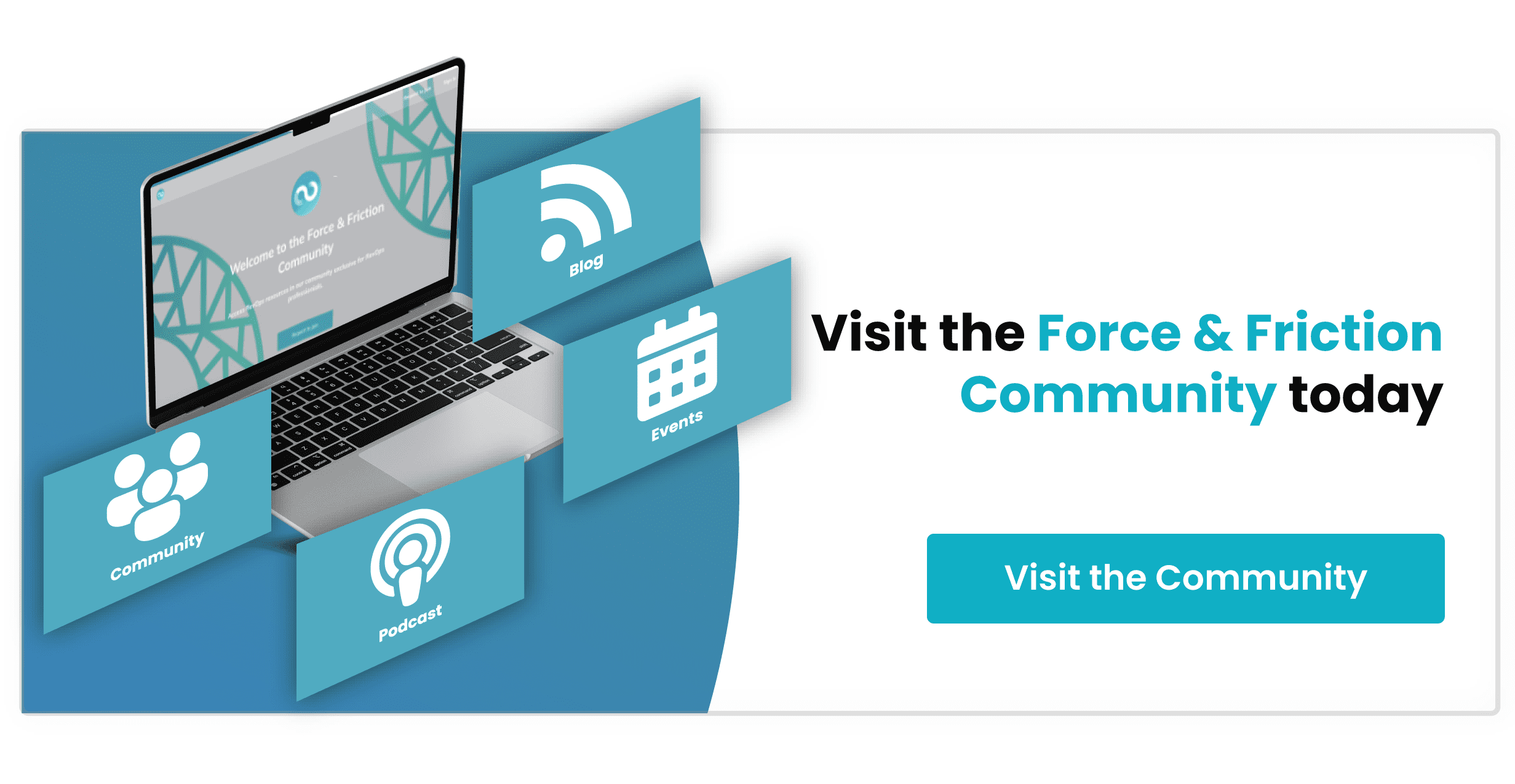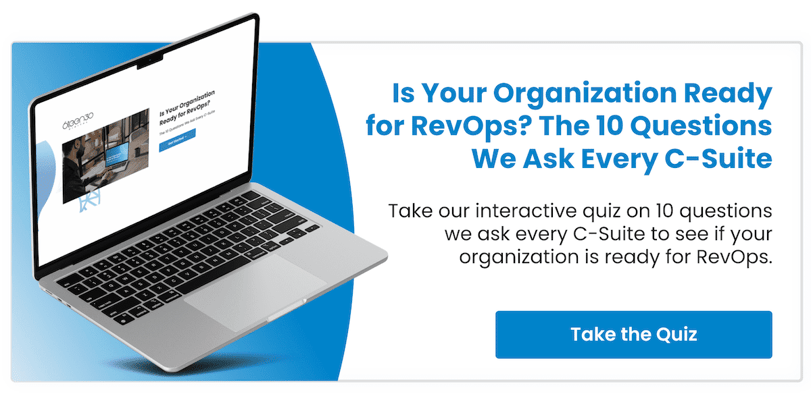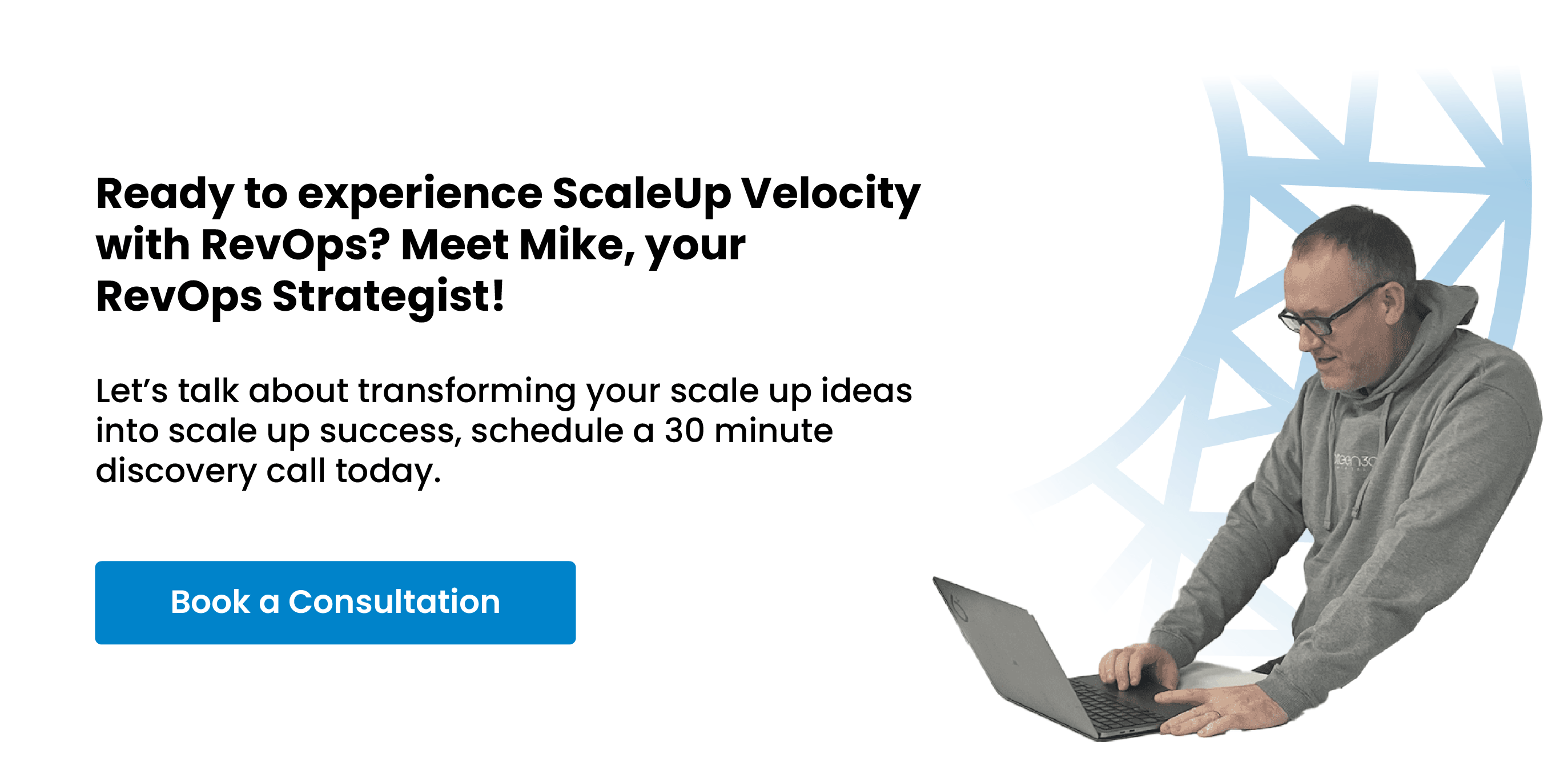
Is Your Organization Ready for RevOps? The 10 Questions We Ask Every C-Suite | #RevOpsLife
When organizations first consider RevOps, I have found that on most occasions they have engaged in some form of marketing messages, their understanding of what's required is mediocre at best and they have been hooked by the ‘sizzle’ not fully understanding the ‘steak’.
C Suites, CMOS, CROs, COOs and even CFOs see the awesome benefits Revenue Operations provides including my favourite term I use often which summarizes Revops as ‘ The Key to Unlocking Seamless Customer Experience and Predictable Sustainable Revenue Growth’.
All sounds great so far right….
However the reality is Revenue Operations, or RevOps,
-
Requires a strategic approach to managing revenue growth and optimizing the entire customer lifecycle
-
It involves aligning the efforts of sales, marketing, and customer success teams to achieve common revenue goals and deliver that seamless customer experience
The reality is you have restructuring, investments, resources and of course people to undertake change management which the latter can be known to resist.
So while the ‘Sizzle’ is awesome, the ‘Steak’ takes work, a lot of commitment, resources and investment.
Start By Adding RevOps to Your Next Board Meeting Agenda
It is important to note that a successful implementation of a RevOps function requires the support and investment of the C-Suite board. If you don't have it, or cant get it STOP!!
Until that support is secured, signed off at board level and authorization for a potential / partial organization / process restructure which may even mean some of your people don't make the cut, your RevOps project is doomed to fail.
How 6teen30 Digital Adds Positive Friction To Our Sales Process
While the benefits of RevOps are clear, many organizations may not be ready to implement this approach. In this RevOpsLife article I explore 10 questions to help gauge your organization's readiness for RevOps and ensure that it is understood, supported, and invested in by the C-Suite board.
Ultimately these are the questions we ask in our RevOps agencies sales process to our prospects, we call it adding in ‘positive friction’ to ensure we dont bring in clients that are unwilling to put in the work, make the difficult decisions to enjoy the results Revops brings.
Preparing for the Board Meeting
As stated earlier, this needs board discussion, debate and approval, it should not be a casual item dealt with in the AOB (any Other Business) section of an already over running board meeting.
So here's a few recommendations for you as the RevOps champion who is tabling this (usually the CEO) but can be any other C Suite member, to prepare for the board meeting when introducing the 10 questions to assess your organization's readiness for RevOps.
Like any board item that has a fundamental impact on the business, it's important to come prepared for a productive and thoughtful discussion.
-
Set clear objectives:
Before the meeting, define the objectives you hope to achieve by introducing the 10 questions. This could include assessing your organization's current revenue growth strategy, identifying areas for improvement, and determining if your organization is ready for RevOps.By setting clear objectives, you can guide the discussion and ensure that the board stays focused on the key questions.
-
Research the questions:
Take the time to research each of the 10 questions and be prepared to provide context and examples during the discussion - share the questions with your board in advance in your report.
This will help ensure that the board has a clear understanding of each question and can engage in a meaningful discussion. -
Encourage debate:
Encourage board members to debate and share their opinions on each question. This will help ensure that all perspectives are considered and that any potential issues or concerns are addressed. -
Score each question:
Ask board members to score each question out of 10 based on their perception of your organization's current readiness for RevOps. This will provide a useful benchmark for future assessments and help identify areas for improvement. -
Agree on next steps:
At the end of the meeting, agree on next steps based on the outcomes of the discussion. This may include allocating resources to support the implementation of RevOps or conducting further research to address any areas of concern, an initial budget to approach a specialized RevOps agency or Consultant.
By following these recommendations, you can ensure that your board meeting is productive and that the discussion around the 10 questions to assess your organization's readiness for RevOps is focused, thoughtful, and meaningful.
The Questions & Scoring Matrix
These are the 10 critical questions that we ask board members and you should ask internally.
These questions cover a range of topics, including how you currently measure and track revenue growth, your willingness to invest in a dedicated RevOps function, and your commitment to data-driven decision-making.
By answering these questions and scoring your organization's readiness (each question out of 10) and your organization's readiness out of 100, you can better understand your current position and identify areas for improvement to successfully implement a RevOps function.
While you still have lots of investigation to do, it will provide you with a healthy debate, the appetite of the board to get onboard and also for you to understand how far away from the 100 score your Ready for RevOps Gap is, while i've never seen anyone score 100, over 75% is great score to get moving forward positively.

1: How do you currently measure and track revenue, and are you satisfied with your current revenue growth rate?
The first step in assessing your organization's readiness for RevOps is to evaluate how you currently measure and track revenue through the entire customer journey. Are you satisfied with your current revenue growth rate? If not, it may be time to consider implementing a RevOps function to optimize your revenue streams.
2: Are you willing to invest the necessary financial and people resources to build a dedicated RevOps function that's approved at board level and implemented throughout the entire organization?
Implementing a RevOps function requires significant investment in financial and people resources. It is essential to obtain approval at the board level and ensure that the function is implemented throughout the entire organization. This will require a commitment from leadership to prioritize RevOps and invest in the necessary resources to make it a success.
3: Are you prepared to make organizational changes to support the implementation of a RevOps function, such as restructuring or creating new teams, departments, or roles?
Implementing RevOps may require organizational changes to support its implementation. This may include restructuring or creating new teams, departments, or roles to align sales, marketing, and customer success efforts. It is essential to have the support of the entire organization and be prepared to make necessary changes to ensure the success of RevOps.
4: How do you prioritize revenue growth compared to other business objectives, such as cost-cutting or product development?
To implement RevOps successfully, revenue growth must be prioritized up the priority list and over some other business objectives. It is essential to have a clear understanding of your organization's priorities and align them with the implementation of RevOps.
5: How do you currently measure the effectiveness of your sales, marketing, and customer success teams, and are you satisfied with the results?
Evaluating the effectiveness of your sales, marketing, and customer success teams is essential to understanding the impact of RevOps on your revenue growth. It is important to have clear metrics in place to measure the effectiveness of these teams and to ensure that the results are aligned with your revenue growth objectives.
6: How well do your sales, marketing, and customer success teams currently collaborate, and what barriers exist to better collaboration?
Collaboration between sales, marketing, and customer success teams is critical to the success of RevOps. It is essential to evaluate how well these teams currently collaborate and identify any barriers that exist to better collaboration. This may include process inefficiencies, communication breakdowns, or misaligned objectives.
7: How willing are you to change established sales and marketing processes to better align with customer needs and improve revenue growth using tech like the HubSpot CRM Professional or Enterprise Suite?
Implementing RevOps will almost certainly require changes to established sales and marketing processes to better align with customer needs and improve revenue growth. It is essential to be willing to make these changes and to use tools like the HubSpot CRM Suite to support these efforts.
8: How comfortable are you with data-driven decision-making, and are you willing to invest in data analytics tools to support a RevOps function?
RevOps relies heavily on data-driven decision-making to optimize revenue growth. It is important to be comfortable with this approach and willing to invest in data analytics tools like Databox to support a RevOps function. This will enable your organization to make informed decisions that drive revenue growth in real time against the company's Key Numbers.
9: How do you currently measure customer satisfaction and retention, and how important is customer retention to your business?
Measuring customer satisfaction and retention is critical to the success of RevOps. It is essential to have a clear understanding of your customers' needs and to be able to measure their satisfaction with your products or services. Customer retention is also critical to revenue growth, as retaining existing customers is often more cost-effective than acquiring new ones. It is important to prioritize customer satisfaction and retention in your RevOps strategy.
10: How committed are you to a 12-36 month timeline for implementing a fully optimized RevOps function with a new role of Head of RevOps being part of your management team?
Finally, it is important to have a clear timeline for implementing a fully optimized RevOps function. This may take anywhere from 12 to 36 months, this timeline is dependent on the complexity of your organization and the resources you have available.
However, it can be a challenging undertaking, and it is highly recommended to consider hiring a Head of RevOps, a specialist revOps Agency like 6teen30 Digital, or a skilled RevOps consultant, either way they should have a seat and the board's support as part of your management team.
The RevOps function requires a range of specific skills that are interconnected and not disparate, which requires management at the RevOps function level. This can be achieved through a Head of RevOps role or partnering with a reputable agency with a proven track record of successfully implementing RevOps functions.
Investing in the necessary resources and expertise will increase the likelihood of success and help achieve your revenue growth objectives.
So does a score below 75% mean you are not RevOps Ready?
The reality is it means you would have a lot more to do internally with your team and attitude to change to successfully implement RevOps with as least pain as possible. It is possible to successfully implement RevOps with a lower than 50 score, however, the timeline and resources including financial will be greater. The larger the gap, the longer and more resources it will take. The golden rule is if the board is not fully onboard and supporting it, then it will still be doomed to fail.
Conclusion
Implementing a RevOps function can be a significant undertaking, but the benefits are clear.
By aligning sales, marketing, and customer success efforts and optimizing the entire customer lifecycle, organizations can achieve common revenue goals and deliver a seamless customer experience.
If you've answered the 10 questions and determined that your organization is ready for RevOps, now is the time to take action.
To ensure a successful implementation, we recommend booking a consultation with one of our RevOps strategists who can review your answers and provide expert guidance and recommendations on the best next steps for your organization.
Like our team of RevOps strategists, I am resident in many boardrooms, we are even able to undertake your Consultation review as an extension of your board meeting to work and answer questions for the entire board.
By partnering with a reputable RevOps specialist like 6teen30 Digital, you can gain access to the expertise and resources needed to optimize your revenue growth and deliver a seamless customer experience.
Don't miss out on the opportunity to achieve your revenue growth objectives – book a consultation with me today!







%20-%20Teal.png?width=500&height=130&name=Force%20%26%20Friction%20-%20Branding%20-%20Logo%20(White)%20-%20Teal.png)